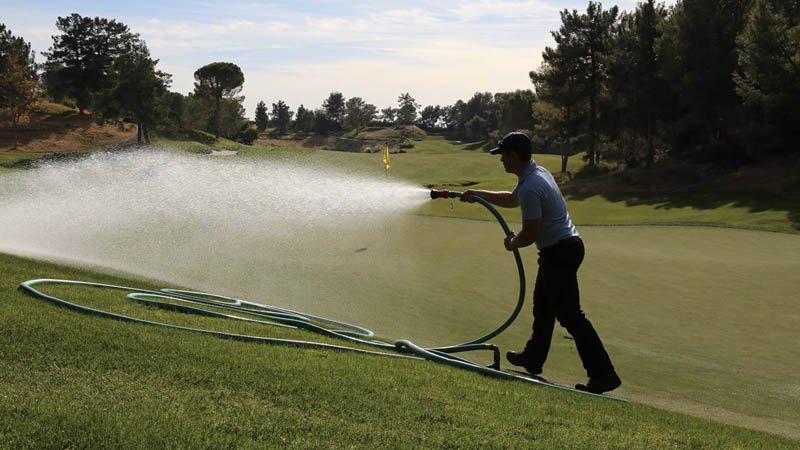
More than 500 miles separate Chicago and Knoxville. For superintendents growing cool-season grass, the upper Midwest and eastern Tennessee have much more in common than meets the eye. At least this year, anyway.
A warm spell in late winter followed by a cooler-than-normal spring and blistering hot temperatures by late May have conspired to make the spring and summer of 2018 an inhospitable growing environment for cool-season grasses, say a handful of leading turf scientists.
"It was hot and humid by Memorial Day and dollar spot was severe by then. We usually don't see that until late June," said Purdue turfgrass pathologist Rick Latin, Ph.D. "Those 90-degree temperatures Memorial Day weekend put the turf under a great deal of stress.
"It was cool and dry in April at a time when Poa is supposed to be thriving and rooting itself. It was held back because of those low temperatures and dryness and prolonged late winter. Then by Memorial Day is was so hot and raining all the time. The Poa never got the rooting it needed in April and May. By June and July, what roots were there were not enough to support the plant."
Up the road from Purdue in Chicago, weather conditions have been on a roller coaster run from late winter through late spring.
In February, the low for the month was minus-3 on Feb. 5 and the high was a balmy 66 on the 20th. In March, the thermometer never reached 60 once. The high reached just 58, and that came on the last day of the month. By Memorial Day, the temperature had reached a scorching 97 degrees, a full 21 degrees above the monthly average.
"The problems we're seeing this summer probably were set into place in February. These conditions hastened the decline of Poa," Latin said. "We don't see this every year. It's something we see once about every 10 years."
The story has been much the same in Knoxville, where a record high for February of 81 degrees on Feb. 23 beat the historic average of 54 by 27 degrees.
The average high for March is 61, but the highest temperature this year was 78 degrees on St. Patrick's Day. By April, the average daily high was nearly 5 degrees below normal, followed by mid-90s by mid-May.
That set the stage for less-than-ideal growing conditions for those in the transition zone who grow bentgrass, said Brandon Horvath, Ph.D., of the University of Tennessee.
"By now, whatever troubles you have are baked in. If you're struggling now, you're going to struggle until you get cooler weather," Horvath said. "Now, you just have to follow the hippocratic oath: Don't do something dumb and cause more damage than what you already have."
That means every disease known to man that we've seen so far is going to stay active all the way through August. And who knows what we have for the fall?
Horvath said most transition zone superintendents he visits have become very good at managing moisture, and thus avoiding disaster during the summer. That's because they know two numbers from their soil meters - the point near wilt and the point near field capacity, and applying water early in the morning so as to avoid both of them.
"When I speak at events, I talk about how good superintendents in the transition zone are," he said. "They know how to lose just a little bit of turf without losing whole greens.
"They know that when you put water down when it's 86 and humid, those stomata are closed and there is no evapotranspiration in the afternoon. The plant is not moving water. Thinking the plant needs water in the afternoon to cool off is a misguided notion. You need to encourage air movement and air-filled porosity in the soil."
Ohio State's turf pathology department has been flooded with disease samples since late spring.
Todd Hicks, the department's program manager, said in his latest Turf Tips video that the disease cycle in Ohio is running about a month ahead of schedule.
He said most of the superintendents he has talked with have managed to avoid any full-blown disasters in what has been a trying summer. The bad news, he said, is there is a lot of summer weather left.
"Don't take your foot off the gas. Be proactive with chemicals and cultural practices trying to relieve stress from diseases on turf, because whatever you have show up is not going to go away and you're not going to grow out of anything. Not really with what we're seeing," Hicks said in the video. "That means every disease known to man that we've seen so far is going to stay active all the way through August. And who knows what we have for the fall?"
Hicks suggested altering some cultural practices throughout the summer, as well.
"Superintendents who have done well have taken away one rolling or more if on a rolling pattern, or they're raising mower heights, and they seem to be doing fairly well," Hicks said. "I know that goes against the grain of trying to have a super slick fast green, but the take-home point is it's better to have a little slower green now than have no green in the fall."


